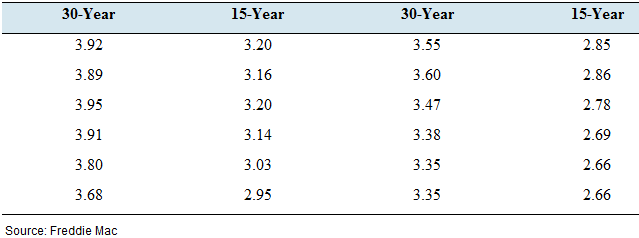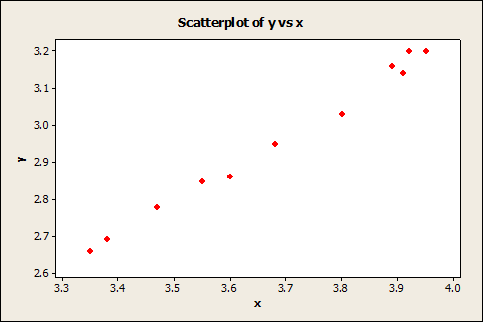
Concept explainers
Mortgage payments: The following table presents interest rates, in percent, for 30-year and
15-year fixed-rate mortgages, for January through December, 2012.

- Compute the least-squares regression line for predicting the 15-year rate from the 30-year rate.
- Construct a scatter-plot of the 15-year rate (y) versus the 30-year rate (x). Graph the least-squares regression line on the same axes.
- Is it possible to interpret die y-intercept? Explain.
- If the 30-year rate differs by 0.3 percent from one month to the next, by how much would you predict the 15-year rate to differ?
- Predict the 15-year rate for a month when the 30-year rate is 3.5 percent.
a.
To compute:The least squares regression line for the
Answer to Problem 26E
The least square regression line of the given data set is,
Explanation of Solution
The mortgage rate for
Calculation:
The least-square regression is given by the formula,
Where
The correlation coefficient is given by the formula,
Let

The correlation coefficient can be obtained by the following table.
Hence, the correlation coefficient is,
Then, the coefficient
Therefore,
Conclusion:
The least square regression line is found to be,
b.
To graph:The scatter plot for the two mortgage rates.
Explanation of Solution
Graph:
Taking the

Interpretation:
We can clearly observe that there is a strong linear relationship between these two parameters in the positive direction.
c.
To explain:The interpretation of the
Answer to Problem 26E
No, the
Explanation of Solution
The lease-square regression line has been computed in the part (a) s,
By the constant
The
Note that a rate of mortgage cannot be negative.
Conclusion:
Therefore, the
d.
To calculate:The difference in the percentage of the
Answer to Problem 26E
The
Explanation of Solution
The lease-square regression line has been computed in the part (a) s,
Calculation:
Let the initial
Also, the increased rate should be
Simplifying the obtained weight,
Therefore, the difference of two weights should be,
Interpretation:
According to the calculation, the
e.
To find:The predicted
Answer to Problem 26E
When
Explanation of Solution
Calculation:
When the
By substituting this value into the least-square regression line of the relationship, we can obtain the corresponding
Conclusion:
The predicted
Want to see more full solutions like this?
Chapter 4 Solutions
Connect Hosted by ALEKS Online Access for Elementary Statistics
- The following data show the year to date percent change (YTD % Change) for 30 stock-market indexes from around the word (The Wall Street Journal, August 26, 2013). Click on the datafile logo to reference the data. DATA file Country Australia Index S&P/ASX200 YTD % Change 10.2 Belgium Bel-20 12.6 Brazil São Paulo Bovespa -14.4 Canada S&P/TSX Comp 2.6 Chile Santiago IPSA -16.3 China Shanghai Composite -9.3 Eurozone EURO Stoxx 10.0 France CAC 40 11.8 Germany DAX 10.6 Hong Kong Hang Seng -3.5 India S&P BSE Sensex -4.7 Israel Tel Aviv 1.3 Italy FTSE MIB 6.6 Japan Nikkei 31.4 Mexico IPC All-Share -6.4 Netherlands AEX 9.3 Singapore Straits Times -2.5 South Korea Kospi -6.4 Spain IBEX 35 6.4 Sweden Switzerland SX All Share 13.8 Swiss Market 17.4 Taiwan Weighted 2.3 U.K. FTSE 100 10.1 U.S. S&P 500 16.6 U.S. DJIA 14.5 U.S. Dow Jones Utility 6.6 U.S. Nasdaq 100 17.4 U.S. Nasdaq Composite 21.1 World DJ Global ex U.S. 4.2 World DJ Global Index 9.9 a. What index has the largest positive YTD %…arrow_forwardDescribe a three step process you choose to determine how many elementary schools there are in the city of 5 million people.arrow_forwardQuiz: Exam 1 (Ch 1-4) z Scores Table-3.pdf x + edu/courses/308627/quizzes/2442507/take/questions/48957332 Canvas Hall It browser 5 Connect Set as default incorrect. • This exam is NOT resumable. Meaning, once you start the exam, you must complete it in its entirety. Any blank questions will be marked as By taking this exam, you agree to adhere to the academic integrity standards, which consist of NOT cheating in any way. To get the highest possible score, you are encouraged to review your notes before taking the exam. You may use your notes during the exam, but note that you should be familiar with the concepts and formulas before taking exam. z Scores Table.pdf Question 3 3 pts Here is a data from a survey asking young children how many hours they spend playing video games. The researchers reported the percent of boys and girls who played no games, less than 1 hour per day, 1-3 hours per day, or greater than 3 hours per day. The most common number of hours per day that boys played is…arrow_forward
- Write a Regression summary explaining significance of mode, explaining regression coefficients, significance of the independent variables, R and R square. Premiums earned Net income Dividends Underwriting Gain/ Loss 30.2 1.6 0.6 0.1 47.2 0.6 0.7 -3.6 92.8 8.4 1.8 -1.5 95.4 7.6 2 -4 100.4 6.3 2.2 -8.1 104.9 6.3 2.4 -10.8 113.2 2.2 2.3 -18.2 130.3 3.0 2.4 -21.4 161.9 13.5 2.3 -12.8 182.5 14.9 2.9 -5.9 193.3 11.7 2.9 -7.6arrow_forward1- Let A = {A1, A2, ...), in which A, A, = 0, when i j. a) Is A a π-system? If not, which element(s) should be added to A to become a π-system? b) Prove that σ(A) consists of the finite or countable unions of elements of A; i.c., A E σ(A) if and only if there exists finite or countable sequence {n} such that A = U₁An (Hint: Let F be such class; prove that F is a σ-filed containing A.) c) Let p ≥ 0 be a sequence of non-negative real numbers with Σip₁ = 1. Using p₁'s, how do you construct a probability measure on σ(A)? (Hint: use extension theorem.) 2- Construct an example for which P(lim sup A,) = 1 and P(lim inf An) = 0.arrow_forwardIn a town with 5000 adults, a sample of 50 is selected using SRSWOR and asked their opinion of a proposed municipal project; 30 are found to favor it and 20 oppose it. If, in fact, the adults of the town were equally divided on the proposal, what would be the probability of observing what has been observed? Approximate using the Binomial distribution. Compare this with the exact probability which is 0.0418.arrow_forward
- Good explanation it sure experts solve itarrow_forwardBest explains it not need guidelines okkarrow_forwardActiv Determine compass error using amplitude (Sun). Minimum number of times that activity should be performed: 3 (1 each phase) Sample calculation (Amplitude- Sun): On 07th May 2006 at Sunset, a vessel in position 10°00'N 010°00'W observed the Sun bearing 288° by compass. Find the compass error. LMT Sunset: LIT: (+) 00d 07d 18h 00h 13m 40m UTC Sunset: 07d 18h 53m (added- since longitude is westerly) Declination (07d 18h): N 016° 55.5' d (0.7): (+) 00.6' Declination Sun: N 016° 56.1' Sin Amplitude = Sin Declination/Cos Latitude = Sin 016°56.1'/ Cos 10°00' = 0.295780189 Amplitude=W17.2N (The prefix of amplitude is named easterly if body is rising, and westerly if body is setting. The suffix is named same as declination) True Bearing=287.2° Compass Bearing= 288.0° Compass Error = 0.8° Westarrow_forward
- Only sure experts solve it correct complete solutions okkarrow_forward13. In 2000, two organizations conducted surveys to ascertain the public's opinion on banning gay men from serving in leadership roles in the Boy Scouts.• A Pew poll asked respondents whether they agreed with "the recent decision by the Supreme Court" that "the Boy Scouts of America have a constitutional right to block gay men from becoming troop leaders."A Los Angeles Times poll asked respondents whether they agreed with the following statement: "A Boy Scout leader should be removed from his duties as a troop leader if he is found out to be gay, even if he is considered by the Scout organization to be a model Boy Scout leader."One of these polls found 36% agreement; the other found 56% agreement. Which of the following statements is true?A) The Pew poll found 36% agreement, and the Los Angeles Times poll found 56% agreement.B) The Pew poll includes a leading question, while the Los Angeles Times poll uses neutral wording.C) The Los Angeles Times Poll includes a leading question, while…arrow_forwardAnswer questions 2arrow_forward
 College AlgebraAlgebraISBN:9781305115545Author:James Stewart, Lothar Redlin, Saleem WatsonPublisher:Cengage Learning
College AlgebraAlgebraISBN:9781305115545Author:James Stewart, Lothar Redlin, Saleem WatsonPublisher:Cengage Learning Algebra and Trigonometry (MindTap Course List)AlgebraISBN:9781305071742Author:James Stewart, Lothar Redlin, Saleem WatsonPublisher:Cengage Learning
Algebra and Trigonometry (MindTap Course List)AlgebraISBN:9781305071742Author:James Stewart, Lothar Redlin, Saleem WatsonPublisher:Cengage Learning
 Elementary Linear Algebra (MindTap Course List)AlgebraISBN:9781305658004Author:Ron LarsonPublisher:Cengage Learning
Elementary Linear Algebra (MindTap Course List)AlgebraISBN:9781305658004Author:Ron LarsonPublisher:Cengage Learning Functions and Change: A Modeling Approach to Coll...AlgebraISBN:9781337111348Author:Bruce Crauder, Benny Evans, Alan NoellPublisher:Cengage Learning
Functions and Change: A Modeling Approach to Coll...AlgebraISBN:9781337111348Author:Bruce Crauder, Benny Evans, Alan NoellPublisher:Cengage Learning Glencoe Algebra 1, Student Edition, 9780079039897...AlgebraISBN:9780079039897Author:CarterPublisher:McGraw Hill
Glencoe Algebra 1, Student Edition, 9780079039897...AlgebraISBN:9780079039897Author:CarterPublisher:McGraw Hill





